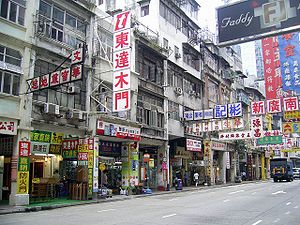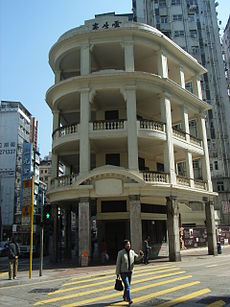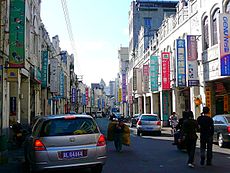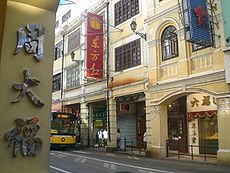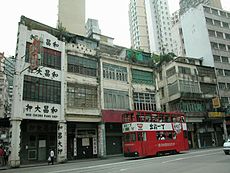- Tong Lau
-
Tong Lau (唐樓) or Kee-lau (Mandarin Chinese: Qilou) are tenement buildings built in late 19th century to the 1960s in Hong Kong, Macau, southern China and Taiwan. Designed for both residential and commercial uses, they are similar in style and function to the shophouses of Southeast Asia.
Contents
Overview
Tong Lau is essentially a balcony-type tenement building for residential and commercial use. The ground floor portion is reserved for commercial use, mostly by small businesses like pawnshops and food vendors. The upper floors were residential use and catered to Chinese residents of Hong Kong. Most Tong Lau were 2-4 storeys tall and 15 feet (4.5 m) in width.
Early Tong Lau
19th Century Tong Lau encompassed Chinese and European architectural features. The Chinese component was based on building design from southern China, mainly in Guangdong Province. European influences were usually Neoclassical.
The Tong Lau roof used wood and/or Xieding tiles and iron was used for the balconies. The balcony's design was based on the Guangzhou-style. Windows used French styling and were made of wood and glass.
The upper floors were supported by brick pillars and protruded out to the edge of the street.
Inside, the floors were connected by wooden stairs. Most floors ranged from 450-700 square feet with very high ceilings. Top floors were often living quarters for shopkeepers and their family.
Other architectural features of early Tong Laus:
- granite capped balustrades
- decorative urns on the roof
- wooden floors and joists
- Canton floor tiles
An example of early Tong Lau or Kee-Lau is Lui Seng Chun, a reinforced concrete building built in Hong Kong in 1931.[1]
Post War Tong Lau
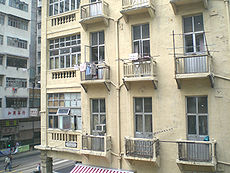 Example of Tong Lau in Sai Ying Pun, Hong Kong.
Example of Tong Lau in Sai Ying Pun, Hong Kong.
Tong Lau built after World War II were simpler in design:
Iron balconies were replaced with concrete ones and later sealed with windows. Roofs were often flat with an open terrace and later renovated to allow for additional residential space.
Wooden windows gave way to stainless steel windows. Air conditioning units were added to the windows in the 1970s and 1980s. Often clothes racks were added below the windows and hung above the sidewalk or street below. Signs were hung on the exterior walls and protruded onto the streets below.
Other features of the new Tong Lau included:
- mosaic floor tiles
- terrazzo staircase
The post-war boom and influx of immigrants meant Hong Kong ran short of housing. Tong Lau were seen as a solution and many of these buildings were renovated to become rental units.
Rooms on the upper floors were divided into smaller rooms and sublet as units by owners. They would only accommodate bunk beds. The middle of the floor was common space for tenants to eat and stretch. Bathrooms and kitchens were also shared amongst the tenants on each floor. Tenants paid for electricity and water on a monthly basis.
The sublet of floors in the Tong Lau results in changes in housing regulations in Hong Kong (Laws of Hong Kong 123 °F (51 °C) chapter "Building (Planning) Regulations", 46).
After the 1960s, many Tong Lau were demolished to give way to taller apartment and commercial buildings. Comparatively few Tong Lau are found in Hong Kong today.
On the 29th January 2010, there is a significant incident of spontaneous whole-building-collapse at no.45J, Ma Tau Wai Road, Ma Tau Wai, when a five-storey Tong Lau of more than 50 years history suddenly collapsed at approximately 1:43pm. There are four people killed, buried under the debris. Such spontaneous, cascading and complete building-collapse in Hong Kong is quite rare since the Second World War and the incident raised concern of the HKSAR Government and the Hong Kong Public towards the safety of the aging "Tong Lau" population in Hong Kong especially those built with similar specifications about 50 or more years ago.[2]
Tong Lau in Mainland China
 Shopping street in Guangzhou.
Shopping street in Guangzhou.
Southern China, namely cities in Guangdong Province, is where the Tong Lau or Qilou originated in the late 19th century. They were built by wealthy Chinese merchants in the cities like Guangzhou.
Qilou styles varied from Chinese to European:
- Gothic Style
- Nanyang (Southeast Asia) Style
- Ancient Roman Gallery Style
- Imitation Baroque Style
- Modernisme
- Traditional Chinese Architectural Style
Locations in Guangzhou with Qilou:
- Renmin Zhong Road
- Renmin Nan Road
- Shangxiajiu Pedestrian Street, including Dishifu Road
- Yide road especially area around the Sacred Heart Stone House Cathedral
- Wanfu Road
- Taikang Road
- Xinhua Bookstore of Science and Technology on Beijing Road
- Oi Kwan Hotel on Yanjiangxi Road
- 186 Wenming Road
- 139 Dezheng Nan Road
Tong Lau in Macau
Avenida de Almeida Ribeiro in Macau.
Tong Lau are also found in Macau on Avenida de Almeida Ribeiro near the Largo do Senado. Tong Lau are better preserved in Macau, where they did not give way to newer buildings. Upper floors no longer house people and often reused for commercial use. Tong Lau here often feature Portuguese colonial architectural influences.
Tong Lau in Hong Kong
The existence of Tong Laus was a culmination of a series of historic forces from economic development of Hong Kong, Second World War as well as the influx of Chinese migrants to Hong Kong.[3]
In 1898, the government introduced a building and public health ordinance which defined all the buildings including Tong Laus. In 1903, the government introduced a maximum height per storey of 9 feet (2.7 m), with a four storey limit. This explains the general appearance of Tong Laus. Yet, the ordinance changed in 1964, so no Tong Lau was built from then on.[4]
Tong Laus are found throughout Hong Kong (the grading of the buildings is indicated into brackets):
- Central
- Nos. 172, 174, 176 Queen's Road Central / 123, 125, 127 Wellington Street[5]
- Nos. 17, 19 Shing Wong Street
- Nos. 1-12 Wing Lee Street[6]
- Cheung Chau
- Nos. 233, 234, 242 Tai San Back Street[5]
- Lantau Island
- Mong Kok
- No. 119 Lai Chi Kok Road (Lui Seng Chun) (Grade I)[5]
- No. 729 Nathan Road[5]
- Nos. 1, 3 Playing Field Road[7]
- Nos. 177-179[5], 190-204[8], 210-212[8] Prince Edward Road West
- Nos. 600-606, 612, 614, 620-626 Shanghai Street[5][8] (Grade I)
- North Point
- Nos. 89, 91 Electric Road[5]
- Sai Ying Pun
- Nos. 145, 147, 149, 151, 153 Third Street[5]
- Sha Tau Kok
- Nos. 1-22 San Lau Street[5]
- Sham Shui Po
- Nos. 187, 189 Apliu Street[5]
- No. 1235 Canton Road[5]
- Nos. 130, 132 Ki Lung Street[5]
- No. 75 Un Chau Street[5]
- No. 170 Yee Kuk Street[5]
- Nos. 51, 53 Yen Chow Street[5]
- Nos. 269, 271 Yu Chau Street (Grade II)[5]
- Sheung Wan
- No. 1 Queen's Road West[5]
- Wan Chai
- Nos. 369, 371 Hennessy Road[5]
- Nos. 2, 4, 6, 8 Hing Wan Street[5] (Grade II)
- Nos. 60-66 Johnston Road[5]
- No. 8 King Sing Street[5]
- Nos. 1-11 Mallory Street and 6-12 Burrows Street (Green House) (Grade II)[5]
- Nos. 186-190 Queen's Road East (Grade II)[5][9]
- No. 6 Stewart Road[5]
- Nos. 72-74A Stone Nullah Lane (Blue House) (Grade I)[5]
- No. 18 Ship Street (Grade II)[5]
- Yuen Long
- No. 31 Lee Yick Street, Yuen Long Kau Hui[5]
- Nos. 33-35 Nam Mun Hau, Yuen Long Kau Hui[5]
Other areas include: Cheung Sha Wan, Hung Hom, Kwun Tong, Shek Kip Mei, Tai Po, Tsim Sha Tsui, Wong Tai Sin, Yau Ma Tei.
Architects
W.H. Bourne a local Hong Kong architect, was one of a few designers of Tong Lau.
See also
- Shophouse, similar buildings in Southeast Asia
- Architecture of Hong Kong
- Housing in Hong Kong
- Terraced house
References
- ^ Antiquities and Monuments Office - Lui Seng Chun
- ^ Report on the Collapse of the Building at 45J Ma Tau Wai Road, To Kwa Wan, Kowloon. Buildings Department, April 2010
- ^ Urban Renewal Authority : 60 -66, Johnston Road
- ^ Preservation lacks long-term vision. (November 26, 2008). South China Morning Post., p.5.
- ^ a b c d e f g h i j k l m n o p q r s t u v w x y z aa ab ac ad Antiquities and Monuments Office - Introduction to 1444 Historic Buildings
- ^ Urban Renewal Authority : 10-12 Wing Lee Street
- ^ Brief Information on Proposed Grade III Items. See pp 214-215
- ^ a b c news.gov.hk - "20 pre-war shophouses to be preserved" (September 19, 2008)
- ^ Urban Renewal Authority - 186-190, Queen's Road East
External links
- Lee Ho Yin, "Pre-war Tong Lau: A Hong Kong Shophouse Typology", Resource Paper for the Antiquities and Monuments Office and Commissioner for Heritage's Office, 19 April 2010
- Conserve and Revitalise Hong Kong Heritage
- Mallory Street/Burrows Street Project
- Heritage enthusiast battles against the wrecker's ball
- Tong Laus in Wan Chai
- Old Qilou Buildings: Historical Architecture in Guangzhou (Part 1)
- Old Qilou Buildings: Historical Architecture in Guangzhou (Part 2)
Categories:- Chinese architecture
- Hong Kong architecture
- Macau architecture
- Housing in Hong Kong
- Apartment types
- House types
- Cantonese words and phrases
Wikimedia Foundation. 2010.

